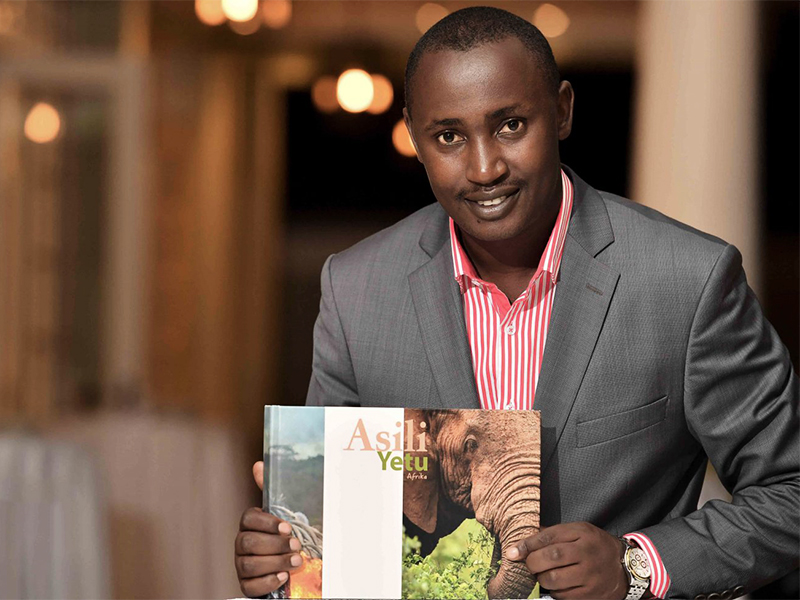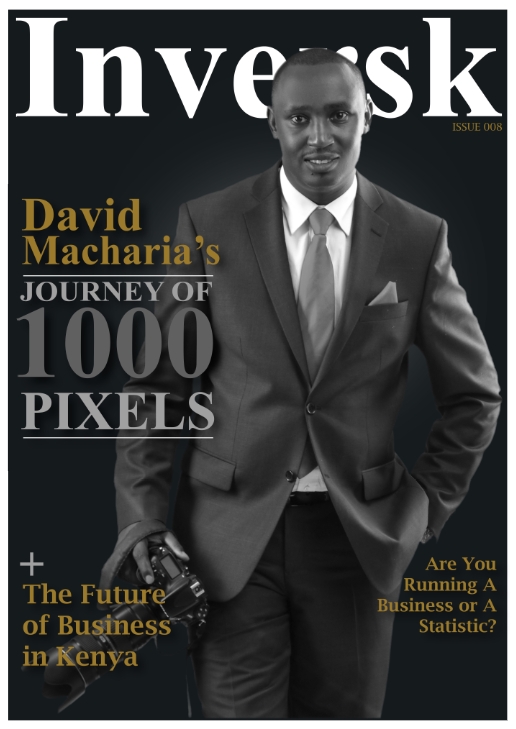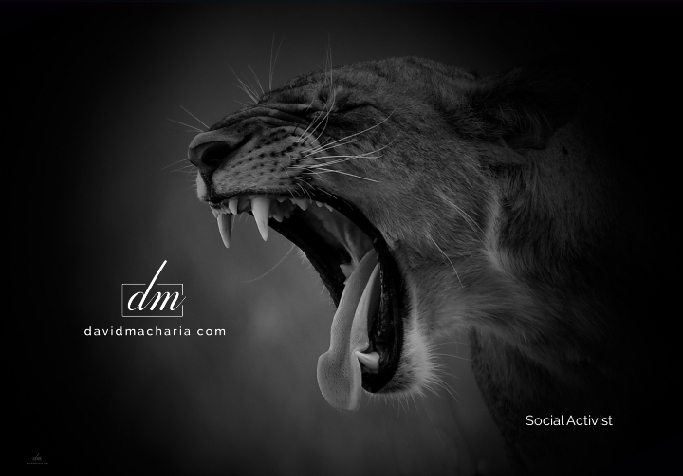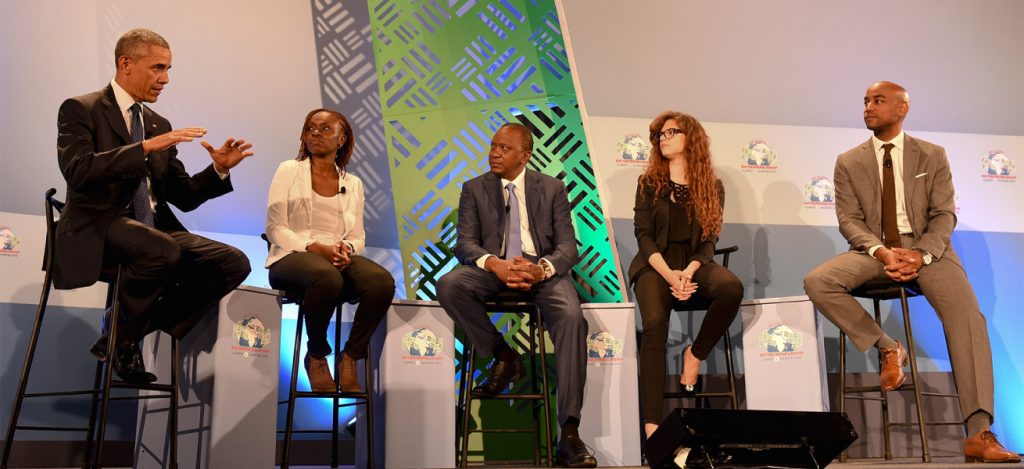Cover Story
How Barack Obama’s ‘Official Photographer’ in Kenya Build His Photography Business

“A photographer never quits being one; a photographer will die a photographer,” says David Macharia, a Kenyan entrepreneur, mentor, father, and a photographer. Many know him as the official photographer for President Obama in Kenya since he converted the 2015 Global Entrepreneurship Summit.
Photography is the one decision that changed Macharia’s entire life and it was a long journey to get to where he is right now.
After clearing high school, Macharia joined his father in business, designing and selling bags in Kinango. “I was very efficient in coming to buy the materials in the city, Nairobi and after the bags were sawed I could sell them.” Because of all that he got exposure on how to run a business.
Macharia is grateful that his dad taught him the value of money. The people in his father’s circle saw the work he did and were impressed by his job. At some point, one of them approached him seeking his sales services for some of his projects which he agreed to.
In 2000, Macharia was invited to Nairobi and he started hawking cards in the streets. Since the city council was always on his case, he had to find an alternate way to sell his cards. His sister was schooling at Daystar University; he, therefore, decided to go sell his cards there, after all, that is where his market was at, the youth.
All this time, Macharia never used to make profits and so his employer didn’t have enough money to even pay him, so he requested him to get him a job before he goes to college. In those days being in the city was the in thing and so he had to do everything possible to stay. His dad wanted him to go back and continue with the business but he assured him of his return once he gathered enough exposure to the business world.
His boss finally got him a place to work, Mwangaza studio. Things were different at Mwangaza, everything he knew about the city was not exactly as easy as he thought it to be. He had to be trained on how to talk to people, how to handle clients, and how to print photos. Photography was not an easy task but he struggled till he learned all the necessary skills to help him survive and sustain his job.
By 2003 Macharia had finally understood his way around photography to a point where he began advising other photographers on how to take good photos. He recalls some complaining about how badly the photos were printed yet they were the ones who made mistakes, like not taking the photos in a good setting, etc. This experience triggered Macharia’s interest in photography. So he began to sneak into the studio to learn about the camera and know how it works.
One day he met Mr. Kanini, a proficient photographer and out of interest Macharia sought to learn from him. He joined Kanini in his venture and work. He would attend weddings with him, hold his bags as he watched him do the work and learn. Weeks later he was amazed not only by the photos he took but also discovered that photography was a journey he needed to prepare for. He didn’t have money to buy a camera hence had to continue with his job at the studio.
By the end of 2003, the people in his hood, Kangemi, would ask why he never took photos of them yet he always had a Kodak shirt on. This was the turning point for Macharia. He combined the business skills he had learned from his dad, borrowed a camera from the studio in the evening, and took photos at night. The following day he would take them to the studio, print then take them back to the owners, in a frame! And his clients would get shocked at how he used to deliver the photos within a day! And in a frame! Because back then, it took weeks or months to get a photo delivered. As a result, he got more clients as days went by and his name grew in his neighborhood.

David Macharia on the cover of Inversk Magazine
He recalls sometimes having so many clients and considering he used to work at night had to say no to some. At this point, he realized that he needed a strategy on how he could still maintain his day job and take photos of his clients at the same time. So during his days off work, he would take photos the entire day. And this made his service demands shoot even the more.
Out of huge demand, and quick money involved, Macharia decided to resign and start his career as a photographer. He still didn’t own a camera, and therefore took advantage of that of his mentor’s, Mr. Kanini, who worked as a banker during the weekdays and so Macharia could run his errands and at the same time take photos to earn money.
He started taking photos in Kangemi. The downside of this story is that the anticipation he had of the many people needing his services was cut off and his bills needed to be paid. Unlike other times when he only had the night to work with, now he had a full day to himself and so once again begun for clients who needed to take photos. He would walk in the streets of Kangemi, his coat full of pockets with his portfolio, looking for and building clientele. His customers were mostly house helps and the children in the estate because they were always at home, then on Sundays, he would take photos of the whole family which he charged each at KES 50.
The parents now began referring to him even in their places of work and since cooperates also needed professional photographers he would be called in. From there, Macharia started networking. He says, “Every time I met a client, I would build a good relationship to ensure that anytime they needed a photographer, I would be the first person who would come to their mind. And even to date, I do the same.”
He finally managed to get his own camera thereby became even more flexible in his service delivery. He began meeting other photographers, worked for them as a learning process, and also sold photos to them (a paparazzi kind of work).
In 2005 he met Boniface Mwangi, inquired about media photography, and decided to join the standard media group. He was given assignments that never raked in good money. He could earn KES. 500 per assignment and in case his photo didn’t make it to the newspapers, got nothing.
He began doing fashion photos for the Pulse segment with a dream to just see the caption ‘photography by David Macharia’ in the papers. However, the assignments were not giving him enough income so he quit and decided to concentrate on his clients who gave him value. “After all, I couldn’t eat out of dreams alone.” He embarked on building his portfolio which without a doubt was good. People loved his work. He concentrated mostly on weddings, family portraits, cooperates, and mostly the work passed to him by fellow photographers.
Finally, at a wedding, he got his big break. He met a baker, Matthew (owner of Valentine Cake house) who asked him to take 3 photos of his cake. He knew Matthew was one of the key players in the wedding industry, and so decided to take more photos of the cake in different angles and framing. He delivered the photos to him and Matthew impressed by the work he did begin recommending Macharia to his own clients for photography services.

Clients literally swarmed in his directions. He confesses that he didn’t even know how to charge them at first. From the money he got, he started buying other equipment’s especially the digital camera that could satisfy the kind of market he was getting himself into.
In 2007, Mathew managed to make an arrangement with Kiss FM to cover a wedding that they had organized. He was called in for an interview and found himself in a board room with a panel consisting of Caroline Mutoko. Macharia narrates, “At first they couldn’t believe that I was the one who did the work in my portfolio. But since I was the only photographer who could match the standard of work they needed I was offered the job.”
It was one of the biggest weddings that happened that year, Pan Victorian wedding, he had to go look for other photographers to be able to cover the event. This was the ‘it wedding’ and everyone who was someone in this country had their eyes glued to it. Macharia’s work was all over the media.
He was now able to get more clients who were able to pay for his services, he even increased his prices, and clients still thronged. He attracted so much clientele to a point where he started referring them to other photographers as he was fully booked. But still, the clients needed his services and at this point, he realized he was losing out on a lot of money and so he decided to register his company.
Versatile Photographers! That is how the company was born. “I must, however, confess that coming up with a name for the company was hard.” He was inspired by Richard Branson’s Virgin brand logo, “It looks young and classy, it can connect with young people” he says, and he desired the same feeling for his company’s name. The only thing that came to his mind was versatile, he could have named his company unique photographers but that was too ordinary, he needed a vibrant name.
Versatile represented, and still represents the different kinds of photos he takes. They were not just any other pictures; he had a variety of tastes in photos he was producing.
He began looking for other photographers to team up with but most looked down upon him; after all, he was just a beginner, while others simply had a bad attitude towards him. ‘There was lack of professionalism”, he cites. But even this didn’t get to him, rather probed him to work harder.
Macharia needed more staff to help run his company, but in as much as he acquired more employees, he ended up disappointed at the productivity yielded. So he began a mentorship program, if a candidate was good and displayed exemplary work, he could hire them. He has mentored the best photographers in the country such as Thomson Kube and Ben Kiruthi. He even mentored his sales team on how to sell a package.
He finally had his own website put up as he continued to obtain more lessons online making him deliver more excellent photos to his clients. In 2011, he had a big team of photographers but couldn’t still manage the inquiries he had. He even went further and increased his service charges but still, clients came back such that he couldn’t handle the traffic. He decided to search for more photographers online, joined them in a group on Facebook, and called it Photographers Association of Kenya. In the group, he exchanged ideas and merged people together to help each other. It is now a registered association.
Finally, he was able to get a bigger office and space for the studio at Hazina towers 9th Floor. Just when he had settled in with all his equipment that was worth Ksh. 4 million, he got robbed. At this point, he hit the deep end and almost got into depression. He, however, had to start afresh, and as fortune would have it, he was back on his feet again and took off again!
In 2015, Macharia got a call from the white house in the USA to be the official photographer and cover Barack Obama’s Global Entrepreneurship Summit in Kenya.

President Barack Obama and his counterpart Kenyan President Uhuru Kenyatta at the GES Summit in 2015 when the US president visited Kenya | Photo by Versatile Photographers
Macharia says he couldn’t believe that they wanted him. He was given a brief of what needed to be done and according to them, his work was up to standard. He went through a series of interviews and finally, the day arrived. Simply summed up, “It was the best experience I have ever had and will never forget.” After that, his company’s name went viral.
He still continued with his mentorship programs, till it got overwhelming for him and couldn’t handle the crowd. He, therefore, sat down with the people he had mentored came up with a curriculum and started a school called Versatile School of photography which in the near future he hopes to be a university. They are teaching people hands-on skills, how they can start their own business as they don’t need to seek employment.
One thing that he has really built on is that his business can still run without him. He had to come up with an effective system that runs his business because he has plans to branch out, soon to the Village Market (already launched the office in 2018) and also Tanzania. He needed a system that can manage and run all branches at the same time from the customer service to his workshops in a particular order. He doesn’t have a huge team but works with creative people who he empowers to begin their own ventures.
Macharia’s Advice To Most Employers
Never limit a creative person. For instance, asking them to come to work from 8 a.m-5 p.m they like working in their space and comfort to be able to be creative and productive and you can’t fight and stop them. Macharia had to come up with a system for them too when to deliver their work, how to deliver, all this was geared towards making their work easier and for the efficiency of his company and for their own personal brands too.
Why bring them together?
When the ocean rises the boats will rise too. That is why he believes in bringing more photographers together, mentoring, and teaching them. He believes photography has not yet been fully tapped in Africa. He has met other international photographers while on assignments, and the more he goes out the more he feels the need to develop photography in Kenya.
Where Does Macharia Get His Inspiration
Macharia prays to God but also seeks counsel from his mentors when he feels like he is lost. He regularly attends short training programs available to learn and get more ideas just to stay on course.
Why Versatile Is Unique
Our efficient service delivery and the quality of the work we produce. The versatile team is amazing and we thrive in professionalism which brands us as a company.
Best Advice Ever Received
It is from his mentor Mathews, when you have grown accept that you have grown. To get there you will need help and when you achieve greatness you will need to mentor others. For you to shine you will need to help others shine more.
The future of Versatile…
The next time you hear of Versatile Photographers, expect a leading university in photography in Africa. The school is a combination of many innovations of photography in Africa like fine art in photography and wildlife.
One life lesson he carries dearly to date, he learned in South Africa. He went to KFC and had their chicken and it was awesome, later on a branch was opened in Kenya and when he tried their chicken it was exactly of the same taste and quality as that he had in South Africa. As he thinks of opening up branches globally, that is the exact quality he wants to emulate; that of quality duplication.
There is also a stock image company coming up which will be a storage of images taken in Africa. The photos will be posted online just like shutter stock where people can be able to buy images online.
He also has the vision to change the story of our own country and Africa as a whole. We have so many untapped resources and at the same time there are so many investors looking for places to invest in, someone needs to highlight these resources and tell a pictorial story. During the interview, I was stunned to find out that we have a desert safari, a beach, and boat rides in Turkana that I had no clue existed.







